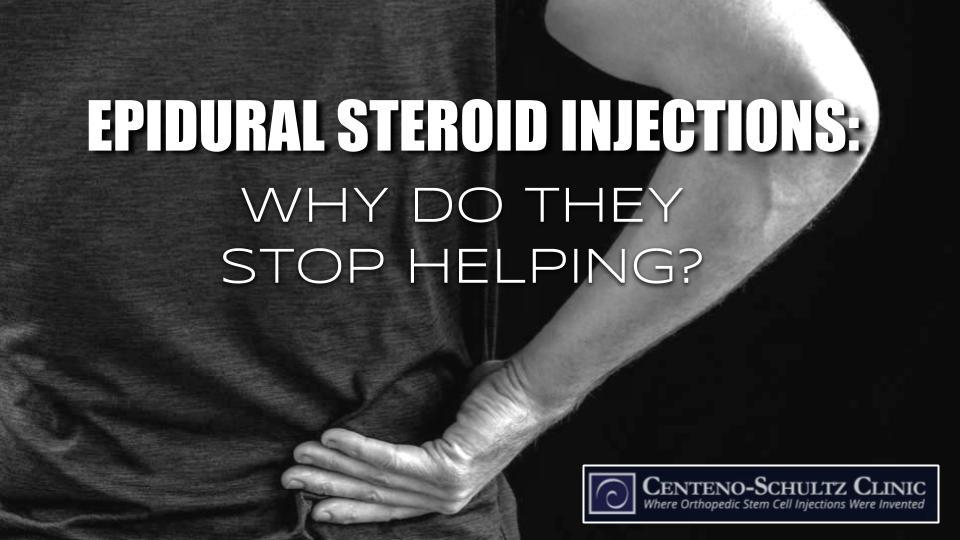Epidural steroid injections are extremely common treatments provided for irritated or inflamed spinal nerves. These irritated nerves can cause pain in the area of the nerve in the back or neck or pain anywhere along the nerve branch in areas that nerve supplies, such as the knee, shoulder, hip, and so on.
They might seem like an almost miraculous, albeit temporary, solution for treating pain and inflammation, and that first injection may have you wondering why you waited so long to get it. However, besides the many known side effects, which we’ll review in a moment, you might notice that you’re getting less and less relief with each epidural steroid injection. So why do some patients experience this? Before we provide our answer to this question, let’s review some of those awful side effects of steroids.
The Problems with Steroids
In women middle-aged and older, with each epidural steroid injection, spinal fracture risk has been shown to increase by 29% due to bone loss. This isn’t the only increased risk found in women getting epidural steroid injections—vaginal bleeding can also occur after the shot. This link also shows that in diabetics, steroids can lead to poor control of blood sugar.
The ability of the brain to respond to inflammation and stress can also be affected by epidural steroid injections as one study suggests they inhibit the HPA (hypothalamus-pituitary-adrenal) axis. This effect on the HPA axis actually can last as long as three weeks following the injection. Considering the common administration of these steroid injections is once a week for three weeks, this disruption can linger for quite some time and cause problems regulating hormones. It can also disrupt energy reserves and increase illness susceptibility in addition to creating issues with the nervous system and immune function.
Steroid problems aren’t just associated with epidural injections. Steroids injected in the knees have also been linked to adrenal problems with as much as 60% of patients reporting this issue even two months following the shot. We also know that steroids are toxic to knee cartilage and that studies show that they lack efficacy for significant pain relief in the knee.
Our Theory on Why You Get Less Pain Relief with Repeated Epidural Steroid Injections
First, watch Dr. Centeno’s brief video on why repeated epidural steroid injections often have diminishing relief, and then read our summary below.
So why is that for many, that first epidural steroid injection feels really good, the second feels OK, and by the third, that magical pain-relief effect no longer feels so magical?
Based on the research and our own copious lab data, we believe this diminishing relief happens because the high-dose steroids used in epidural injections are toxic to the local stem cells. These are those cells in the area that maintain the tissue, suppress inflammation, and coordinate repair when there is a problem. In addition, many of the anesthetics that are injected with them are also toxic to those cells. So, for example, when you have a bulging disc that is causing a pinched nerve, the stem cells would play a key part in taming that inflammation and repairing the damaged disc. So when these high-dose steroids enter the scene, the following is how this is likely to play out:
- First epidural steroid injection: There is typically a major anti-inflammatory effect, and this may ease patients’ pain temporarily. Unfortunately, some stem cells are also destroyed.
- Second epidural steroid injection: There will still be an anti-inflammatory effect. However, fewer stem cells means less repair and maintenance in the local tissue. Add to this, the death of even more stem cells.
- Third epidural steroid injection: Pain relief is diminishing as the steroids destroy the remaining viable repair cells.
Platelet Lysate: A Regenerative Treatment Alternative
Natural growth factors isolated from the patient’s own platelets (our fourth-generation platelet lysate [PL]) are a treatment alternative to the toxic effects of high-dose epidural steroid injections. Injected around the irritated nerves, instead of killing the local stem cells, PL works like an espresso shot for the stem cells, waking them up and helping them get to work coordinating repair and maintenance.
If you haven’t yet pulled the trigger on a series of epidural steroid injections, or even if you have and are seeking a regenerative solution, consider talking with your interventional orthopedic physician. He or she may be able to address your issues at the source and help you spare your local healing stem cells and save them from the toxic effects of steroids.

